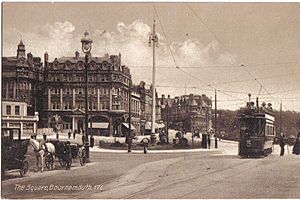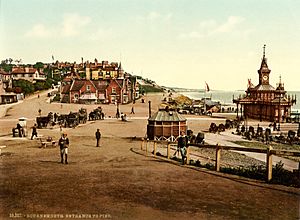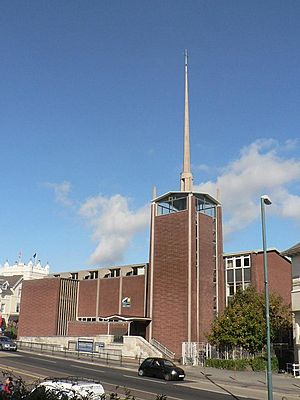History of Bournemouth facts for kids
The history of Bournemouth tells the story of how this coastal town in Dorset, England grew over thousands of years. Bournemouth is located on the island of Great Britain in the United Kingdom.
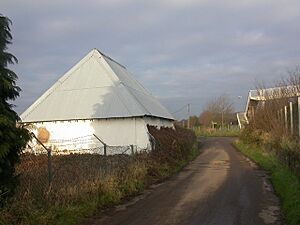
Contents
Bournemouth Before It Was a Town
Around 1800, the area where Bournemouth now stands was mostly wild, empty land. It was a heathland, which is a type of open land with low-growing plants like heather and gorse. This area was known as 'Bourne Heath'.
It was a popular spot for smugglers, who secretly brought goods like spirits, tea, and tobacco ashore. One famous smuggler, Isaac Gulliver, is even seen as one of the people who helped start Bournemouth.
Nearby, there were small villages like Kinson, Throop, Holdenhurst (where the oldest building is), and Iford. But the land between them was just a wilderness of pine trees, gorse, and ferns. The spot we now call central Bournemouth was known as 'Bourne Mouth', because it was where the Bourne Stream met the sea. No one lived there, only a few fishermen and smugglers visited.
The eastern part of this heath was called the Liberty of West Stour. It was divided into areas like 'Muscliff' and 'Holdenhurst'. These were common land, meaning local people could use them to graze animals or collect wood.
How Bournemouth Became Private Land
Before 1802, most of this land was common land, meaning everyone could use it. But the Christchurch Inclosures Act 1802 changed everything. This law, and a plan called the Inclosure Commissioners' Award of 1805, turned hundreds of acres into private property for the first time.
Three Commissioners were chosen to divide the land. They also planned roads and sold plots of land to pay for their work. Ordinary people who depended on the common land were worried they would lose their rights. However, they managed to get some land set aside for them.
Five areas, totaling about 425 acres, were kept for the local people. Today, these are known as 'Meyrick Park', 'Queen's Park', 'King's Park', 'Redhill Common', and 'Seafield Gardens'. These parks are still held in trust for the community.
More than half of the land sold was bought by two men. William Dean bought 500 acres, including the West Cliff. Sir George Ivison Tapps, the local lord, bought 205 acres, including the East Cliff and part of central Bournemouth. Sir George decided to plant thousands of pine trees on his land. These trees, along with the fresh sea air, were very important for the town's future.
In 1809, the first building appeared on the heath: a pub called the Tapps Arms. It was a favorite spot for smugglers and later became Bournemouth's first post office.
The First Settlers in Bournemouth
In 1810, a retired army officer named Lewis Tregonwell visited the area. He found only a small stream leading to the sea. There was also a new inn nearby. Captain Tregonwell and his wife loved the area so much that they bought land and built a home. This building is now part of the Royal Exeter Hotel.
Tregonwell also planted many pine trees, creating sheltered paths to the beach. The town slowly grew around these scattered pine trees. Even 25 years after the Tregonwells built their home, Bournemouth was still a very small community.
Bournemouth Grows as a Seaside Resort
After Sir George Ivison Tapps died in 1835, his son, Sir George William Tapps-Gervis, took over. He began to develop Bournemouth into a seaside resort, like Weymouth and Brighton. Sir George hired an architect, Benjamin Ferrey, to plan the new town.
The first two hotels opened in 1838. One was the Bath Hotel, which later became the Royal Bath. The other was the Belle Vue Boarding House, which stood where the Pavilion is today. The 1830s also saw the start of the Bournemouth Gardens.
Bournemouth got its first church in 1838. Before that, people had to travel to nearby towns for Sunday services. The church was made from two cottages and also served as a schoolroom during the week.
In 1840, the name "Bournemouth" was officially used as a single word.
A Doctor's Visit Changes Everything
In 1841, Bournemouth was still small, but that was about to change. A famous doctor named Augustus Bozzi Granville visited. He wrote a book called The Spas of England, which described health resorts. After his visit, Dr. Granville added a chapter about Bournemouth to his book.
This book helped put Bournemouth on the map as a perfect place for people with health problems, especially chest illnesses. Bournemouth quickly became a popular destination for wealthy holidaymakers and people seeking the healthy sea air.
In the 1840s, the fields south of the main road crossing (now The Square) were drained and turned into beautiful gardens. In 1849, a bridge was built over the Bourne Stream, creating the beginning of The Square.
Managing the Growing Town
In 1856, the Bournemouth Improvement Act was passed. This law created a board of 13 Commissioners to manage the town's services, like paving roads, sewers, street lighting, and cleaning. Under their surveyor, Christopher Crabb Creeke, the Commissioners worked to improve Bournemouth and make it more appealing to visitors. They governed the town until 1890 and were the first version of the Bournemouth Borough Council we have today.
By the 1860s, more fields were turned into walks and gardens. In the early 1870s, all these fields were leased to the Commissioners. These areas now form The Pleasure Gardens, which run through the center of town.
As Bournemouth grew, the railways arrived, making it even easier for people to visit the seaside. Important people like Sir Percy Shelley (son of the famous writers Percy Bysshe Shelley and Mary Shelley) and Sir Merton Russell-Cotes helped develop the town.
How People Traveled in Bournemouth
Trains Arrive in Bournemouth
On March 14, 1870, the London and South Western Railway Company opened Bournemouth's first railway station. This made it much easier for people to travel to the town.
Over the next few years, more stations opened, including the main station we know today in 1885. This new station was designed by William Jacob. The building of these railway links helped Bournemouth become a very popular place to visit.
Trams and Trolleybuses
From 1902 to 1936, Bournemouth had a tramway system. Trams ran between Bournemouth, Poole, Christchurch, and Winton. Sadly, in 1908, a tram accident on Avenue Road killed 7 people.
The tram system started closing down in 1929, replaced by motorbuses. One old Bournemouth tram, number 85, is still preserved today at the Museum of Electricity in Christchurch.
The town also had a large network of trolleybuses, which ran from 1933 until 1969.
Gardens and Important Buildings
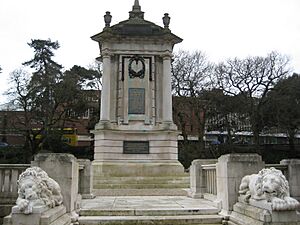
The Pleasure Gardens are still a very important part of Bournemouth. The Central Gardens contain the town's impressive war memorial, which is guarded by two stone lions. This memorial was put in place in 1921. The lions were copied from statues that guarded the tomb of Pope Clement XIII.
A large hospital for chest diseases, called a sanatorium, used to overlook the Central Gardens. It has since been turned into retirement homes, but its unique chapel remains. Next to this sanatorium was the grand Mont Dore Hotel, which is now Bournemouth Town Hall. In the 1880s, this hotel was famous for its luxury and even had one of the first telephones in England! During the First World War, it was used as a hospital for wounded soldiers.
Even though fewer sick people came to the town later on, Bournemouth was still growing fast. The town center became busy with theaters, concert halls, cafés, cinemas, and more hotels.
The History of Bournemouth Pier
Bournemouth's first pier was a short wooden jetty, finished in 1856. This was replaced by a longer wooden pier in 1861. However, tiny sea worms called Teredo worms damaged the wood, so iron supports were added in 1866.
Despite the repairs, a strong storm in 1867 destroyed part of the pier. After more repairs, another severe storm in 1876 caused more damage, making the pier too short for steamboats. The old pier was then taken down.
A new pier, designed by Eugenius Birch, opened on August 11, 1880. It cost £2,600 and was 838 feet long. In 1885, a bandstand was added, and military bands played concerts there often. The pier was extended twice, reaching over 1000 feet long.
During World War II, on July 5, 1940, Bournemouth Pier was partly destroyed by soldiers. This was a precaution to stop German invaders from using it. The pier was repaired and reopened in August 1946.
More work was done in the 1950s and 1960s, including rebuilding parts in concrete. In 1979, a big £1.7 million restoration project began. The old buildings at the start of the pier were replaced with a new two-story complex, and the pier's neck was rebuilt in concrete, giving it its modern bridge-like look. This work finished in two years.
Today, if you want to walk on the pier during peak season (April to October), there's a small charge.
Bournemouth During World War Two
During World War II, Bournemouth experienced air raids. The coast around Bournemouth was very important during the war. For example, Poole Harbour was a departure point for many ships involved in the D-Day landings.
Bournemouth itself was not a main target for bombing, but German bombers sometimes dropped their extra bombs on the town. During the war, 219 civilians were killed by bombs, and almost 14,000 buildings were damaged.
The Methodist Church on Exeter Road was destroyed, and 77 people died there. In 1944, a Halifax Bomber crashed in Moordown, killing nine people.
Entertainment Venues
The Winter Gardens
Bournemouth's first big entertainment place was the original glass Winter Gardens, built in 1875. It was home to the town's orchestra, which is now the famous Bournemouth Symphony Orchestra. Famous composers like Elgar and Sibelius conducted there.
In 1935, the original Winter Gardens was taken down. A new one opened two years later. This new building had amazing acoustics (sound quality) and became the orchestra's new home after the war. Before the BIC (Bournemouth International Centre) opened, the Winter Gardens hosted many major entertainers, including The Beatles and Queen. Sadly, the building was demolished in May 2006.
The Pavilion and Westover Road Cinemas
The Pavilion was built in 1925. Famous actors like Ralph Richardson performed there. The Pavilion faces the cinemas and shops of Westover Road, which is known for its fancy stores.
Westover Road's Odeon cinema started as the Regent in 1929. It still has many of its original art deco features. It used to host live shows as well as films. Stars like Ella Fitzgerald and even The Beatles performed there.
The nearby ABC cinema opened in 1937. Both cinemas closed in early 2017 to make way for a new Odeon complex called BH2.
Bournemouth Today
After World War II, Bournemouth, like many other English seaside resorts, saw fewer tourists. However, the town's population continued to grow. In 1880, about 17,000 people lived here. By 1990, that number had grown to 150,000, and it's even higher today.
In 1974, Bournemouth moved from Hampshire to Dorset in a local government change. In 1997, Bournemouth became a unitary authority, meaning it manages its own local services.
On September 15, 1980, Bournemouth got its own independent radio station, 2CR FM. Its name means '2 Counties' Radio' because it broadcasts to parts of Dorset and Hampshire.
The town has also grown in business and tourism. The Bournemouth Big Wheel at Pier Approach offers amazing views of the beach and town.
In the 1990s, a leisure complex with an IMAX cinema was built near Bournemouth Pier. Many locals disliked the building because it blocked the sea view. It was even voted one of the buildings people most wanted to demolish on a TV show! The building was finally taken down in 2013 to create an open public space.
Bournemouth was the first local council in the UK to install CCTV cameras in public places in 1985.
In 2003, a new £9.5 million Bournemouth Library was completed. It won an award for its good design and low cost.
In recent years, Bournemouth has attracted many jobs in financial services. Big companies like JP Morgan Chase have major offices here, employing thousands of people. In fact, the financial sector is now Bournemouth's biggest source of income, even more than tourism.
On April 28, 2015, AFC Bournemouth made history by getting promoted to the Premier League for the first time since the club started in 1899.
In February 2017, a new complex called BH2 opened in the town center. It has a modern cinema with reclining seats and many restaurants. This replaced the old Odeon and ABC cinemas.
In 2019, Bournemouth Council was abolished. Bournemouth became part of a new larger council area called Bournemouth, Christchurch and Poole.
|


